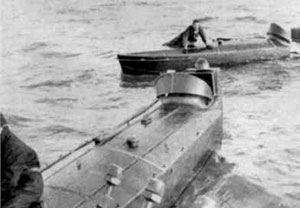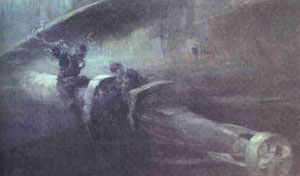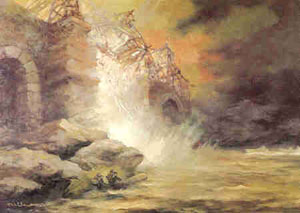| The Unfortunate
Action
By Kevin Canada
July 2013
During the siege of Malta in 1941, the Italian
Supermarina and Regia Aeronautica repeatedly
attempted to interdict the island's supply
line by attacking the various convoys loaded
with troops and supplies. One small convoy
of six merchant ships and a fleet fuel carrier
set sail with Force H from Gibraltar on July
21, 1941 during Operation Substance (Scenario
22 in Bomb
Alley), and reached the
island in spite of the Regia Aeronautica's
best efforts.
Galled by the British success, and the ineffectiveness
of their planes, the Italians decided to risk
a night attack on the Maltese port itself
with motorboats and manned torpedoes.

Italian
explosive motor boats of the X Flotilla.
The Italian navy had a long and successful
history with the use of light auxiliary craft
in operations against their enemies, from
the sinking of the Viribus Unitis in World
War I to the manned torpedo attacks in Alexandria
harbor during World War II, crippling the
British battleships Valiant and Queen
Elizabeth. The unit responsible for conducting
these operations was the Decima Flottiglia
Mas (10th Light Flotilla), utilizing everything
from one-man explosive motor boats (EMBs,
equipped with an ejector seat for the crewman)
to two-man submersibles called maiale
("pigs") — which carried
two divers and explosive charges which would
be laid below the keel of an enemy ship —
to high-speed motor torpedo boats (MTBs).
During the first year of the war in the Mediterranean,
Decima Flottiglia Mas had conducted numerous
successful operations, including an attack
on Gibraltar, the sinking of the HMS York
in Suda harbor during the battle for
Crete, and the operation against Alexandria.
On the night of July 25, 1941, the fast naval auxiliary Diana
departed from Augusta in Sicily carrying
eight EMBs. Joining her were two MTBs, each
towing a “pig.” The plan was to
have the “pigs” breach the outer
defenses of the Grand Harbor, allowing the
EMBs to reach the defenseless merchant ships
inside the port and sink them. A diversionary
air raid would be carried out to cover the
approach of the small boats.

Italy’s deadly pig.
Rudolf Claudus, Ufficio Storico della Marina
Militare.
Diana stopped about 20 miles from
Malta and dropped off the EMBs, which together
with the MTBs proceeded toward the Grand Harbor.
Major Teseo Tesei and his crewman Chief Diver
Pedretti were to blow up a section of the
viaduct at the foot of Fort St. Elmo, which
would give the EMBs access.
Luck seemed against the operation
from the beginning. Diana was picked
up by British radar, alerting the defenders
to the possibility of action. Then the covering
air raid ended far too soon. By the time Tesei
exploded his charge on the viaduct, the island's
defenders were like the proverbial angry hornets
defending their nest: The Royal Malta Artillery,
armed mostly with 6-pounder pom-poms, 40mm
Bofors and various small arms, snapped on
searchlights and opened a huge volume of fire
on the entrance to the Grand Harbor. During
the ensuing “battle,” only one
of the EMBs seems to have gotten anywhere
near the harbor entrance, only to explode
against the viaduct, causing its span to collapse
into the water and block the way into the
port. The remainder were shot to pieces by
the Maltese gunners, who had anticipated a
surface attack for months and were just itching
for an opportunity to pay back the Italians.
Within two minutes, every boat was sunk and
most of the attackers dead.

Tesei’s pig explodes against St. Elmo’s
bridge.
Rudolf Claudus, Ufficio Storico della Marina
Militare.
Had the Italians a better appreciation of
the state of Malta's coastal defenses, especially
its radar, they might not have attempted the
operation. Several times during the preceding
months the coastal batteries on the island
had lobbed salvoes at “unseen targets”
at night, using only radar to control fire.
While the defenders assumed these were simply
minelaying missions, the Decima Flottiglia
Mas had in fact been conducting operations
to test Malta's defenses and gain familiarity
with the topography of the island, and these
blind firings may well have been in response
to these actions. Whatever the case, success
frequently breeds contempt, and the brilliant
attacks on Alexandria, Suda and Gibraltar
may have blinded Italian commanders from comprehending
the futility of the plan. Indeed, Mariano
Gabriele, the official historian of Italian
operations during the siege of Malta, referred
to it only as “the unfortunate action.” Click here to order Bomb
Alley now! | 